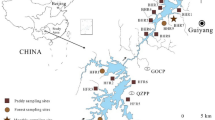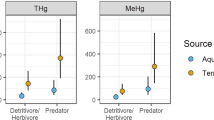Abstract
Riparian communities can receive environmental contaminants from adjacent aquatic ‘donor’ habitats. We investigated mercury biotransport from aquatic to terrestrial habitats via aquatic insect emergence and uptake by riparian spiders at sites within and upstream of the Buffalo River Area of Concern (AOC), a site with known sediment Hg contamination. Mercury concentration in emerging midges was roughly 10× less than contaminated sediment levels with the AOC, but biomagnification factors from midges to spiders ranged from 2.0 to 2.65 between sites. There was a significantly negative body mass:total mercury relationship in spiders (p < 0.001), indicating that mercury depuration is rapid or tissue dilution occurs in these riparian predators. Spiders contained significantly more mercury than their midge prey and spiders upstream of the AOC had higher mercury concentrations than spiders from within the AOC. Collectively, these data indicate that riparian spiders can be good mercury sentinels in urban environments, and that riparian communities upstream from the AOC may be at greater risk to mercury than has been previously considered.



Similar content being viewed by others
References
Adair BM, Reynolds KD, McMurry ST, Cobb GP (2003) Mercury occurrence in prothonotary warblers (Protonotaria citrea) inhabiting a national priorities list site and reference area in southern Alabama. Arch Environ Contam Toxicol 44:265–271
Brimble SK, Foster KL, Mallory ML, Macdonald RW, Smol JP, Blais JM (2009) High Arctic ponds receiving biotransported nutrients from a nearby seabird colony are also subject to potentially toxic loadings of arsenic, cadmium, and zinc. Environ Toxicol Chem 28:2426–2433
Clausen HIS (1984) Lead (Pb) in spiders: a possible measure of atmospheric Pb pollution. Environ Pollut 8:217–230
Collier KJ, Bury S, Gibbs M (2002) A stable isotope study of linkages between stream and terrestrial food webs through spider predation. Freshw Biol 47:1651–1659
Cristol DA, Brasso RL, Condon AM, Fovargue RE, Friedman SL, Hallinger KK, Momroe AP, White AE (2008) The movement of aquatic mercury through terrestrial food webs. Science 320:335
Currie RS, Fairchild WL, Muir DCG (1997) Remobilization and export of cadmium from lake sediments emerging insects. Environ Toxicol Chem 16:2333–2338
Diggins TP, Stewart KM (1998) Chironomid deformities, benthic composition, and trace elements in the Buffalo River (New York) Area of Concern. J North Am Benthol Soc 17:311–323
EPA (2004) The Buffalo River Area of Concern. www.epa.gov/glnpo/aoc/buffalo.html
Evers DC, Jackson AK, Tear TH, Osborne CE (2012) Hidden risk: mercury in terrestrial ecosystems of the Northeast. Biodiversity Research Institute. Gorham, ME. BRI report 2012–07
Gorski PR, Cleckner LB, Hurley JP, Sierszen ME, Armstrong DE (2003) Factors affecting enhanced mercury bioaccumulation in inland lakes of Isle Royale National Park, USA. Sci Total Environ 304:327–348
Hopkin SP (1989) Ecophysiology of metals in terrestrial invertebrates. Elsevier Science Publishing Company, New York
Irvine KN, Perrelli ME, McCorkhill G, Caruso J (2005) Sampling and modeling approaches to assess water quality impacts of combined sewer overflows: the importance of a watershed perspective. J Great Lakes Res 31:105–115
Karimi R, Chen CY, Pickhardt PC, Fisher NS, Folt CL (2007) Stoichiometric controls of mercury dilution by growth. Proc Natl Acad Sci USA 104:7477–7482
Kato C, Iwata T, Nakano S, Kishi D (2003) Dynamics of aquatic insect flux affects distribution of riparian web-building spiders. Oikos 103:113–120
Krabbenholt DP, Sunderland EM (2013) Global change and mercury. Science 341:1457–1458
Liu J, Goa J, Yun Y, Hu Z, Peng Y (2013) Bioaccumulation of mercury and its effects on survival, development and web-weaving in the funnel-web spider Agelena labyrinthica (Araneae: Agelenidae). Bull Environ Contam Toxicol 90:558–562
Marvin C, Painter S, Williams D, Richardson V, Rossmann R, Van Hoof P (2004) Spatial and temporal trends in surface water and sediment contamination in the Laurentian Great Lakes. Environ Pollut 129:131–144
Műller K (1954) Investigation on the organic drift in north Swedish streams. Rep Inst Freshw Res Drottingholm 35:133–148
Paetzold A, Smith M, Warren PH, Maltby L (2011) Environmental impact propagated by cross-system subsidy: chronic stream pollution controls riparian spider populations. Ecology 92:1711–1716
Rabitsch WGB (1995) Metal accumulation in arthropods near a lead/zinc smelter in Arnoldstein, Austria: III. Arachnida. Environ Pollut 90:221–237
Speir SL, Chumchal MM, Drenner RW, Cocke WG, Lewis ME, Whitt HJ (2014) Methylmercury and stable isotopes of nitrogen reveal a terrestrial spider consumes emergent aquatic insects. Environ Toxicol Chem 33:2506–2509
Sullivan SMP, Rodewald AD (2012) In a state of flux: the energetic pathways that move contaminants from aquatic to terrestrial environments. Environ Toxicol Chem 31:1175–1183
Tremblay A (1999) Bioaccumulation of mercury and methylmercury in invertebrates from natural boreal lakes. In: Lucotte M, Schetagne R, Therien N, Langlois C, Tremblay A (eds) Mercury in the biogeochemical cycle: natural environments and hydroelectric reservoirs of northern Quebec (Canada). Springer, Berlin, pp 89–113
Tweedy BN, Drenner RW, Chumchal MM, Kennedy JH (2013) Effects of fish on emergent insect-mediated flux of methyl mercury across a gradient of contamination. Environ Sci Technol 47:1614–1619
Walters DM, Fritz KM, Otter RR (2008) The dark side of subsidies: adult stream insects export organic contaminants to riparian predators. Ecol Appl 18:1835–1841
Walters DM, Mills MA, Fritz KM, Raikow DF (2010) Spider-mediated flux of PCBs from contaminated sediments to terrestrial ecosystems and potential risks to arachnivorous birds. Environ Sci Technol 44:2849–2856
Wong AHK, McQueen DJ, Williams DD, Demers E (1997) Transfer of mercury from benthic invertebrates to fishes in lakes with contrasting fish community structures. Can J Fish Aquat Sci 54:1320–1330
Xiao-li S, Yu P, Hose GC, Jian C, Feng-Xiang L (2006) Spider webs as indicators of heavy metal pollution in air. Bull Environ Contam Toxicol 76:271–277
Acknowledgments
This work was supported by a New York Department of Environmental Conservation, Great Lakes Environmental Protection Fund award to CMP (SUNY RF Award No. 31988). Dr. A. Nazarenko (Buffalo State College) gave graciously of his time in operation of the cold vapor AA. Dr. B. Cutler (University of Kansas) identified the spiders. The manuscript benefitted from the comments of two anonymous reviewers.
Author information
Authors and Affiliations
Corresponding author
Rights and permissions
About this article
Cite this article
Pennuto, C.M., Smith, M. From Midges to Spiders: Mercury Biotransport in Riparian Zones Near the Buffalo River Area of Concern (AOC), USA. Bull Environ Contam Toxicol 95, 701–706 (2015). https://doi.org/10.1007/s00128-015-1658-6
Received:
Accepted:
Published:
Issue Date:
DOI: https://doi.org/10.1007/s00128-015-1658-6




